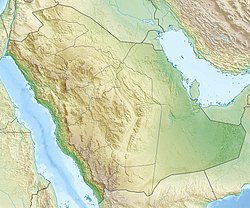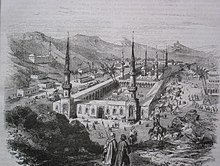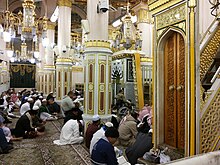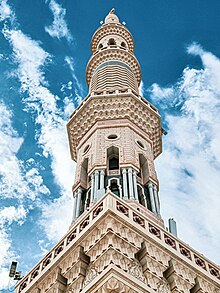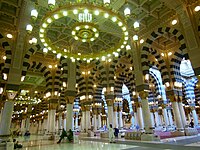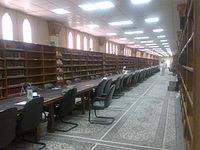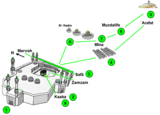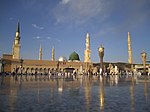A mosque, also called a masjid, is a place of worship for Muslims. The term usually refers to a covered building, but can be any place where Islamic prayers are performed, such as an outdoor courtyard.

Medina, officially Al-Madinah al-Munawwarah and also commonly simplified as Madīnah or Madinah, is the capital of Medina Province in the Hejaz region of western Saudi Arabia. It is one of the oldest and most important places in Islamic history. One of the most sacred cities in Islam, the population as of 2022 is 1,411,599, making it the fourth-most populous city in the country. Around 58.5% of the population are Saudi citizens and 41.5% are foreigners. Located at the core of the Medina Province in the western reaches of the country, the city is distributed over 589 km2 (227 sq mi), of which 293 km2 (113 sq mi) constitutes the city's urban area, while the rest is occupied by the Hejaz Mountains, empty valleys, agricultural spaces and older dormant volcanoes.

Mihrab is a niche in the wall of a mosque that indicates the qibla, the direction of the Kaaba in Mecca towards which Muslims should face when praying. The wall in which a mihrab appears is thus the "qibla wall".
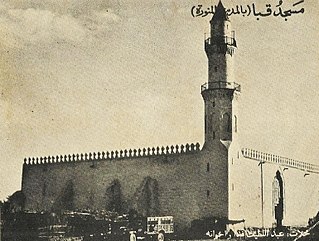
The Quba Mosque is a mosque located in Medina, in the Hejaz region of Saudi Arabia, built in the lifetime of the Islamic prophet Muhammad in the 7th century C.E. It is thought to be the first mosque in the world, built on the first day of Muhammad's emigration to Medina. Its first stone is said to have been laid by the prophet, and the structure completed by his companions.

The Mīqāt Dhu al-Ḥulayfah, also known as Masjid ash-Shajarah or Masjid Dhu al-Hulayfah, is a miqat and mosque in Abyār ʿAlī, Medina, west of Wadi al-'Aqiq, where the final Islamic prophet, Muhammad, entered the state of ihram before performing 'Umrah, after the Treaty of Hudaybiyyah. The mosque is located 7 km (4.3 mi) SW of the Al-Masjid an-Nabawi and was defined by Muhammad as the miqat for those willing to perform the Hajj or Umrah pilgrimages from Medina. It is the second-largest miqat mosque after the Miqat Qarn al-Manazil in As-Sayl al-Kabir.

Dumat al-Jandal, also known as Al-Jawf or Al-Jouf, which refers to Wadi Sirhan, is an ancient city of ruins and the historical capital of the Al Jawf Province, today in northwestern Saudi Arabia. It is located 37 km from Sakakah.

The Masjid al-Qiblatayn, also spelt Masjid al-Qiblatain, is a mosque in Medina believed by Muslims to be the place where the final Islamic prophet, Muhammad, received the command to change the Qibla from Jerusalem to Mecca. The mosque was built by Sawad ibn Ghanam ibn Ka'ab during the year 2 AH and is one of the few mosques in the world to have contained two mihrabs in different directions.

The Great Mosque of Aleppo is the largest and one of the oldest mosques in the city of Aleppo, Syria. It is located in al-Jalloum district of the Ancient City of Aleppo, a World Heritage Site, near the entrance to Al-Madina Souq. The mosque is purportedly home to the remains of Zechariah, the father of John the Baptist, both of whom are revered in Islam and Christianity. It was built in the beginning of the 8th century CE. However, the current building dates back to the 11th through 14th centuries. The minaret in the mosque was built in 1090, and was destroyed during fighting in the Syrian Civil War in April 2013.

The destruction of heritage sites associated with early Islam is an ongoing phenomenon that has occurred mainly in the Hejaz region of western Saudi Arabia, particularly around the two holiest cities of Islam, Mecca and Medina. The demolition has focused on mosques, burial sites, homes and historical locations associated with the Islamic prophet Muhammad, his companions, and many of the founding personalities of early Islamic history by the Saudi government. In Saudi Arabia, many of the demolitions have officially been part of the continued expansion of the Masjid al-Haram at Mecca and the Prophet's Mosque in Medina and their auxiliary service facilities in order to accommodate the ever-increasing number of Muslims performing the pilgrimage (hajj).
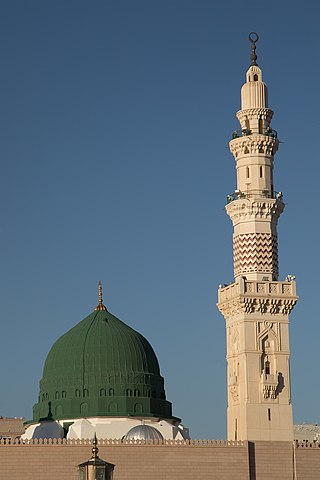
The Green Dome is a green-coloured dome built above the tombs of the Islamic prophet Muhammad and the early Rashidun Caliphs Abu Bakr and Omar, which used to be the Noble Chamber of Aisha. The dome is located in the southeast corner of Al-Masjid al-Nabawi in Medina, present-day Saudi Arabia. Millions visit it every year, since it is a tradition to visit the mosque after or before the pilgrimage to Mecca.

Both Sunni Muslims and Shia Muslims agree on the three holiest sites in Islam being, respectively, the Masjid al-Haram, in Mecca; the Al-Masjid an-Nabawi, in Medina; and the Al-Masjid al-Aqsa, in Jerusalem.

Both Sunni Muslims and Shia Muslims agree on the three Holiest sites in Islam being, respectively, the Masjid al-Haram, in Mecca; the Al-Masjid an-Nabawi, in Medina; and Al-Masjid al-Aqsa, in Jerusalem.
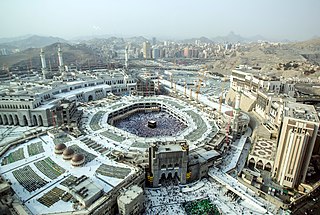
Masjid al-Haram, also known as the Sacred Mosque or the Great Mosque of Mecca, is considered to be the most significant mosque in Islam. It encloses the vicinity of the Kaaba in Mecca, in the Mecca Province of Saudi Arabia. It is among the pilgrimage sites associated with the Hajj, which every Muslim must perform at least once in their lives if able. It is also the main site for the performance of ʿUmrah, the lesser pilgrimage that can be undertaken any time of the year. The rites of both pilgrimages include circumambulating the Kaaba within the mosque. The Great Mosque includes other important significant sites, such as the Black Stone, the Zamzam Well, Maqam Ibrahim, and the hills of Safa and Marwa.
The following is a timeline of the history of the city of Medina, Saudi Arabia.

Mosque of Al-Ghamamah is one of the oldest mosques in Medina, Saudi Arabia, located in the place believed to be where the Islamic prophet Muhammad performed an Eid prayer in the year 631. It is also narrated that Muhammad offered Salat ul-Istasqa when the city of Madina faced a shortage of rain. For a while, this mosque was closed for daily prayers because of its proximity to the Al-Masjid an-Nabawi. However quite recently it has been reopened for the worshipers for praying. Five times prayers are held in this mosque now with an internal sound system to avoid the clash of sounds from the Prophet's Mosque. The mosque is one of the historical relics of Medina.

Al Jum'ah Mosque is a mosque in Medina, in the Hejazi region of Saudi Arabia. Also known as Masjid Banī Sālim, Masjid Al-Wādī, Masjid Al-Qubayb, and Masjid ʿĀtikah, it is said by the locals to be where the Islamic prophet Muhammad and his companions performed Salatul-Jumu'ah for the first time, during their hijrah (migration) from Mecca to Medina.

Al-Ijabah Mosque, also known as "Bani Muawiyah Mosque" or "Al-Mubahalah Mosque", is a mosque in Medina, Saudi Arabia, which was built during the time of the Islamic prophet Muhammad on a land owned by Muawiyah bin Malik bin 'Auf of the tribe of As-Sus.
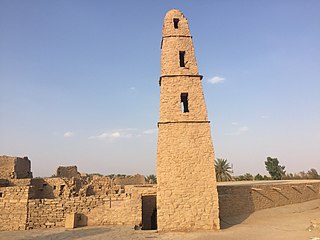
The Mosque of Umar Ibn al-Khattab is a historic mosque in Dumat al-Jandal in northern Saudi Arabia, located adjacent to the Marid Castle. It is one of the oldest mosques in the north of the Arabian Peninsula and is considered one of the important monuments in Al-Jawf and in Saudi Arabia in general.

A sitara or sitarah is an ornamental curtain used in the sacred sites of Islam. A sitara forms part of the kiswah, the cloth covering of the Kaaba in Mecca. Another sitara adorns the Prophet's Tomb in the Al-Masjid an-Nabawi mosque in Medina. These textiles bear embroidered inscriptions of verses from the Quran and other significant texts. Sitaras have been created annually since the 16th century as part of a set of textiles sent to Mecca. The tradition is that the textiles are provided by the ruler responsible for the holy sites. In different eras, this has meant the Mamluk Sultans, the Sultans of the Ottoman Empire, and presently the rulers of Saudi Arabia. The construction of the sitaras is both an act of religious devotion and a demonstration of the wealth of the rulers who commission them.
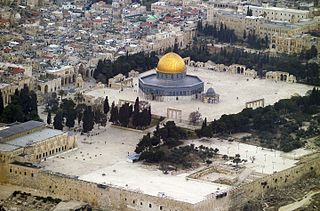
Al-Aqsa or al-Masjid al-Aqṣā is the compound of Islamic religious buildings that sit atop the Temple Mount, also known as the Haram al-Sharif, in the Old City of Jerusalem, including the Dome of the Rock, many mosques and prayer halls, madrasas, zawiyas, khalwas and other domes and religious structures, as well as the four encircling minarets. It is considered the third holiest site in Islam. The compound's main congregational mosque or prayer hall is variously known as Al-Aqsa Mosque, Qibli Mosque or al-Jāmiʿ al-Aqṣā, while in some sources it is also known as al-Masjid al-Aqṣā; the wider compound is sometimes known as Al-Aqsa mosque compound in order to avoid confusion.

